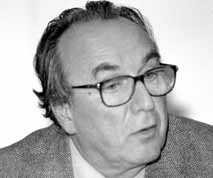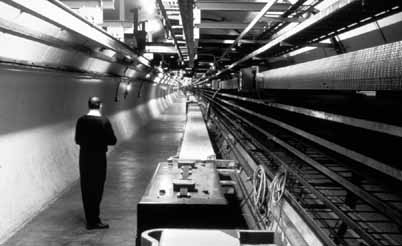 |
|
LEP Shutdown Throws Spotlight on Fermilab by Mike Perricone
While science usually moves in slow steps, the media likes a race. And thus the focus on the Higgs search was thrust upon Fermilab by the announcement on November 8 that the Large Electron-Proton collider had been turned off for the last time.
"We did the best we could," Maiani said. "We believe that it was a decision based on the scientific case."
LEP experimenter Chris Tully of Princeton, one of those who had pleaded for more time in Geneva, was widely quoted when he said: "Fermilab is clearly the next up to bat."
Then the phones started ringing in Batavia, asking about the search for the Higgs boson, reputed to be the source of all mass since its postulation by Scottish physicist Peter Higgs about 35 years ago.
CERN's long-planned transition from running the LEP to constructing the Large Hadron Collider, concurrent with Fermilab's firing up for Collider Run II of the Tevatron in March 2001, took on media elements of a fierce race to the Higgs finish, with one competitor (CERN) forced out prematurely, and the other (Fermilab) now having a clear field ahead for the discovery and a shot at a Nobel Prize.
As always, reality wasn't so simple.
Maiani faced huge added expenses both for prolonging the LEP run (perhaps $60 million) and for delaying the schedule of the LHC.
"Since the next step is so expensive, we had to stop at this point," he said.
Experimenters continued to exert pressure after the announcement, and Fermilab Director Michael Witherell was sympathetic to Maiani's dilemma.
"It really is a decision in which you can't be absolutely sure you're doing the right thing," Witherell said, "because you don't have the right information."
Extending LEP would have meant delays in the LHC, creating ripple effects at Fermilab, a major supplier of components for the next-generation accelerator and detectors, as well as a major experimenter in the LHC era. Jim Kerby, project manager for LHC magnet production at Fermilab, saw little if any impact; work on completing the accelerator components is moving as quickly as possible, independent of the LEP situation.
"It would have been bad," Green said of possible LHC delays. "There are penalty clauses in the contracts for the experimental halls which would, ultimately, take money away from the experiments. There would be delays in beneficial occupancy of the experiments. And there would have been a critical delay in the start of the CMS physics program."
Yet the combination of events underscored these realities in Fermilab's future:
"It's extremely important for our future to demonstrate what Fermilab can do," said John Womersley, co-spokesman of Fermilab's DZero collaboration. "We must make the most of this opportunity. It may never happen again."
Fermilab's 5,000-ton detectors, DZero and CDF, will stage their own intralab rivalry to track down the Higgs if it's there to be found in Run II. But Womersley and CDF co-spokesman Franco Bedeschi both prefer to a talk about seeking a Higgs "mechanism," rather than a single Higgs particle. They agree that the mass-producing property might be the function of more than one type of Higgs particle, or, for that matter, an assortment of particles that includes a Higgs. Those scenarios could strengthen the theory of Supersymmetry; or they could buttress the theory called Technicolor; or they could give rise to ideas that haven't yet been formulated.
"When we talk about a �hunt for the Higgs,'" said Bedeschi, "we actually mean the entire Higgs mechanism, because there are many ways it could operate. In some ways, it would create more meaningful physics if it's more than just one particle that has all the qualities we're looking for."
"A lot of people actually would be surprised if we found one Higgs particle with all the qualities predicted for it," Womersley concurred. "That would, in some ways, be an anticlimax."
They lean differently on the LEP "hints." Womersley credited CERN experimenters with making a strong case for extending the run, while Bedeschi doubts that LEP saw the Higgs.
During its one-month extension, LEP surpassed its design expectation of 200 GeV collision energy, reaching 209 GeV before the shutdown. Womersley said the LEP radiofrequency cavities began heating up, effectively setting the final upper boundary for the accelerator.
At the Tevatron in Run II, Bedeschi said a five-year experimental run would yield about 5x1014 collisions, of which about 3,000 might be candidates for a Higgs particle with 115 GeV/C2 mass. Fermilab's two detectors have their best shots at seeing a Higgs particle in two energy ranges: at around 120 GeV/C2, and at around 160 GeV/C2, depending on the value of the particle's mass compared to that of the W boson mass.
The search for the Higgs has always been a priority of Run II, although the science program has also emphasized the exploration of CP violation in the physics of the bottom quark; increased production and precision measurement of top quarks; and possible observation of supersymmetry particles. After years of construction and upgrades, Bedeschi and Womersley accurately represent the eagerness throughout the lab to get back to "doing physics" and possibly matching such past achievements as the discovery of the bottom (1977) and top (1995) quarks.
Bedeschi recalls the frustration of the 1980s, a tight time for funding, when Fermilab watched CERN create the first proton-antiproton collisions, leading to the Nobel Prize-winning production of the W and Z particles by Carlo Rubbia and Simon Van Der Meer.
"I think we could have competed with CERN for those discoveries if we had had the budget," Bedeschi said.
The budget is always a factor: CERN's annual budget of 1.1 billion Swiss francs converts to about $617.7 million. Congress recently approved $726 million for the entire U.S. high-energy physics program in FY2001, including $277 million for Fermilab. But in March, 2001 Fermilab will continue the search on its own.
"We've had to watch the last two years while LEP was running and coming tantalizingly close to the Higgs," said Womersley. "It was like standing outside the restaurant, looking through the window and watching others have dinner. Now it's our turn." |
| last modified 12/1/2000 email Fermilab |
FRLsDFx9eyfrPXgV
 Director-General Luciano Maiani of CERN, the European particle physics laboratory in Geneva, Switzerland, said LEP's one-month extension had ended with its Nov. 2 shutdown. Maiani acted despite pressures from CERN experimenters for a year-long extension to follow up on "tantalizing" hints for evidence of a Higgs particle at a mass of 115 GeV/C2 announced near the end of LEP's 11-year run.
Director-General Luciano Maiani of CERN, the European particle physics laboratory in Geneva, Switzerland, said LEP's one-month extension had ended with its Nov. 2 shutdown. Maiani acted despite pressures from CERN experimenters for a year-long extension to follow up on "tantalizing" hints for evidence of a Higgs particle at a mass of 115 GeV/C2 announced near the end of LEP's 11-year run.
 But Dan Green had serious concerns over possible rescheduling. Green is Project Manager for the US/CMS collaboration, working on the Compact Muon Solenoid detector for the LHC. Fermilab is the host laboratory for the US/CMS effort, as well as the host lab for software and computing and the research program, including maintenance and operations.
But Dan Green had serious concerns over possible rescheduling. Green is Project Manager for the US/CMS collaboration, working on the Compact Muon Solenoid detector for the LHC. Fermilab is the host laboratory for the US/CMS effort, as well as the host lab for software and computing and the research program, including maintenance and operations.